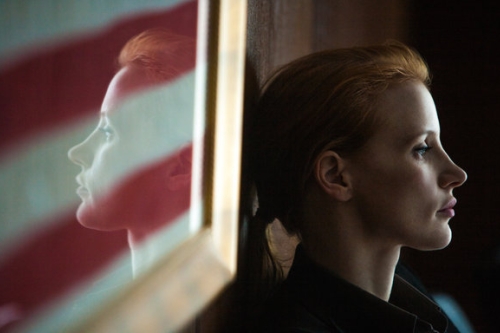
Oscar Hopefuls: Zero Dark Thirty

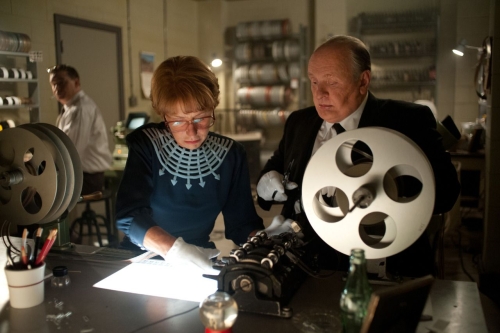
The story of Alfred Hitchcock must
be more interesting than this. The genius behind some of the greatest moments in cinema history gets the standard biopic treatment in Hitchcock. The problem is that it not only fails to live up to the legacy of the man it is trying to capture but it also manages to make him look completely uninteresting.
With the occasional moment managing to hit the right note there is a very real possibility there is an interesting biopic in here somewhere. Certainly the famous shower scene from Psycho is recreated with much love and is the best moment this film has to offer. The film flirts with the idea of Hitchcock being voyeuristic and obsessive but backs off before it gets too controversial.
Anthony Hopkins and Helen Mirren shine in the central relationship between Hitchcock and Alma Reville. These two strong performances manage to bring the film back from the brink as the production of Psycho strains their marriage. The supporting cast however, fades into the background as if they are aware that the film is not really interested in them at all.
Ultimately there is not much that can rectify the major problem with the film, the fact that it falls flat at every turn. There are many question marks surrounding the authenticity of the film’s plot; the biggest of which must be if you’re going to invent the history of Hitchcock, why make it so boring?
2/5
Hitchcock is in UK cinemas now
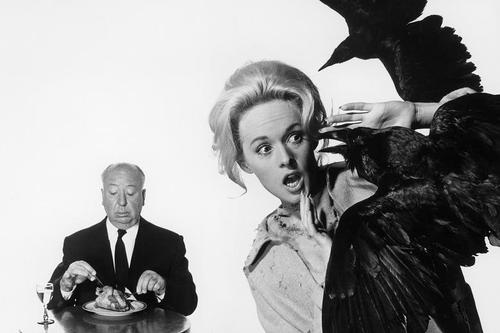
As a rule, I don’t like horror films – not because I scare especially easily but more due to the fact that I am both disgusted and bored by gore. However, I recently read about the relationship between director Alfred Hitchcock and star of The Birds and Marnie, Tippi Hedren, a model and actress discovered by Hitchcock in the early 1950s. Hitchcock’s reported unreciprocated obsession with Hedren effectively ruined her career: her contract with him preventing her from working for anyone else. Perhaps most shockingly of all, however, during five days of filming of the penultimate scenes of The Birds, Hedren was in fact pelted with live birds.
This real life romantic obsession/revenge dynamic was fascinating to me. So, while I may claim not to appreciate the genre, I decided there was analysis to be had in The Birds: also known as My First Hitchcock. Of course, the film has been reviewed numerous times over the years, and there is simply one aspect I want to focus on: the female characters, specifically Melanie. I expected little from the female characters in this film: firstly because it was produced by a man in the early 1960s, but more specifically due to Hitchcock’s feelings regarding Hedren. I was thus pleasantly surprised to discover that, for the majority of the film, Melanie is in her own right a fantastic character. She is confident and strong, warmly charming those around her in order to
achieve her goals. Her relationship with Annie (Suzanne Plechette) is something that I feel modern day film makers could learn a lot from.
(Suzanne Plechette and Tippi Hedren in ‘The Birds’)
Although there is brief animosity between the two invoked by their respective relationships with the male lead, Mitch (Rod Taylor), Melanie and Annie do not treat each other like bitter love rivals, instead respecting each other enough that they even become friends. Perhaps more realistic than the hair pulling cat fights seen frequently in more recent productions. Melanie is also taken seriously throughout the film. For example, when alerting locals in a café to the dangers posed by the gathering birds, she is not dismissed as simply an irrational woman – because she is not. My positive feelings about the film and its female characterisation lasted until the penultimate, bird-chucking scenes. While Mitch and his family sleep in the living room of their house that has been boarded up in order to prevent death-by-beak, Melanie decides it would be a great time to carry out a little exploration upstairs. Naturally, this is when all feathery hell breaks loose. As she slowly climbed the stairs, I felt myself screaming at the screen. Why would a character who has otherwise been so rational and intelligent decide to make this move? Curiosity? Hysteria? Rebellion? It’s fair to say that Melanie’s reputation of rebelliousness precedes her at the beginning of the film, but she adamantly defends herself throughout, both vocally to Mitch, but also in her behaviour. My fear is that she is sent upstairs in order to make Mitch the hero, the stereotypical image of masculinity, carrying Melanie’s limp, injured body back down the stairs and leading the family to safety. I wouldn’t have such a problem with this if that had been the apparent dynamic throughout the movie – but I truly expected more. I did enjoy The Birds. The suspense was fantastic and I appreciated that it resulted from something other than the threat of an axe murderer. I will definitely continue to explore Hitchcock’s work, but my expectations of characterisation have been pared right back once again. It’s a shame, that.
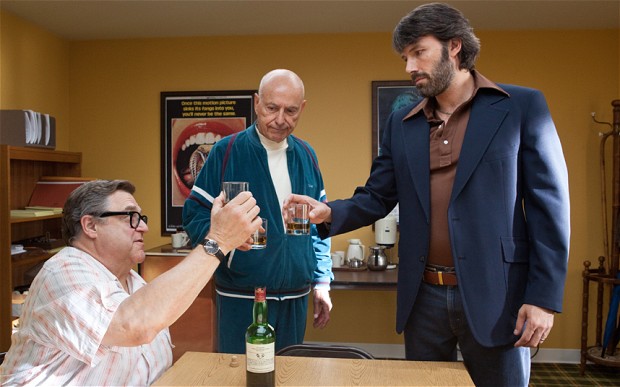
When Good Will Hunting came out, it was always assumed
that it was Matt Damon who did all the graft, and Ben Affleck was the one who was hanging on to Damon’s brilliance – but now, it is being said, maybe it was the other way round. Argo is an incredibly astute work that has all the hallmarks of a brilliant director, especially one with so little directing experience.
The plot is preposterous – in Iran in 1979, protests have broken out and the US embassy is overthrown by the violent mob, with most of the staff taken hostage, with relations between Iran and America suggesting that these hostages may well be killed. However during the confusion 6 staff escaped and are hidden by the Canadian ambassador in his home. While outside anyone accused of being American is killed on site, inside they wait, hoping not to be discovered. Back on US soil, it is decided to try and sneak them out, with their only possible option being a heavily guarded airport. And so fake Canadian identities are constructed to allow them to sneak safely onto a passenger jet, under the pretence that they are supposed to be location scouts for a Sci-Fi movie. With silly looking aliens and crack-pot nonsense. Called Argo. And most ridiculous of all – it’s based on a true story. It really did happen.
Knowing this changes your entire perspective – farce is replaced with tension, humour with fear, as the covert mission faces obstruction after obstruction – the structure and production of the final quarter of an hour has got to be one the most well conceived and nail biting experiences I’ve had thanks to cinema in years.
Oscar Hopes
Having already won the “movie cast prize”
at the SAG, it is clear that Argo has the potential to win big. It really is a staggering film, and few would argue if it ended up getting the Best Picture nod. But. I don’t think it will. It’s nomination categories aren’t across the board, which suggests, and where they exist there are other nominations that seem stronger in each category. The main award looks set to go to Lincoln, and I would even push Silver Linings Playbook ahead in the queue (yes, it really is that good). Elsewhere, the best supporting actor nomination is a damn dense pack of
leading stars, and there was little truly remarkable about Alan Arkin’s role to suggest the night will be his. Next in line are more technical awards – editing (which I feel Life of Pi must be in with a shout) original music (which is fairly unremarkable, and certainly doesn’t stand out as significant, while up against Skyfall) sound editing and mixing (which equally fail to stand out as significant for Affleck’s film) before finally best Adapted Screenplay. If it has a shout, it could be that – but again, it’s a tough, tough group of nominations, including Life of Pi (filming the impossible) Beasts of the Southern Wild (which is so delightful it makes you want to weep), Lincoln and once again, Silver Linings Playbook. As much as it deserves to do well, I have to say, I don’t think Argo will win anything – despite the fact it is a brilliant piece of cinema.


Opening with a montage depicting Nat (Rose Byrne) and Josh’s (Rafe Spall) whirlwind romance that climaxes on their wedding day, “I Give It A Year” is the phrase uttered in the aisles by Nat’s sister (Minnie Driver) which gives this let-down its title. It is overtly clear that Nat, a shallow, career-driven bore, and Josh, a slobbish lad and struggling writer, were doomed from the moment Josh’s obnoxious best friend (Stephen Merchant) sidles into wedding proceedings with an untimely dance number and the best man speech from hell. From thereon, I Give It A Year treads the beaten path of the romantic comedy formula except (TWIST!) the story follows their journey to divorce rather than cathartic smooch [in the rain/on a train platform/in the departure lounge].
Working Title Films are a production company famed for defining the British ‘rom-com’ through their relationship with Richard Curtis. The unbridled success of Four Weddings and Funeral, Notting Hill, and Love, Actually catapulted Hugh Grant into super-stardom and forever gave hope to mumbling fools that they could pass off their social ineptitude as kitsch British charm. Surprisingly, given their track record, Working Title’s latest picture, I Give It A Year, offers an antidote to the tyranny of the rom-com with an unlikely bedfellow in Dan Mazer (Ali G, Borat, Bruno) being given free reign to make an attempt at subverting the well-trodden genre. Unfortunately, the lasting impression left by I Give It A Year is that the only thing worse than a formulaic rom-com is a formulaic anti-rom-com.
There are a plethora of problems with I Give It A Year. For a film trying to throw shade on rom-coms, it, bizarrely, ticks all the boxes of the formula admonished by Mazer with the pretence that it is somehow better than the films it pokes fun at. It feels as if I Give It A Year is expecting a pardon from its audience because it makes self-aware nods and winks to the camera about the constraints of the genre but, ultimately, it is a wolf in sheep’s clothing. In the second act, the story splinters as Nat and Josh are conflicted by love interests which threaten their already broken marriage. Nat is pursued relentlessly by the teeth-gratingly suave Guy (Simon Baker), a business contact who makes it clear that he simply must have her, whilst Josh is re-awakened to the existence of his ex-girlfriend Chloe (Anna Faris), a selfless Earth mother type.
From this point the film plays out like a standard rom-com with the added complication that the focal characters are already in a relationship. The problem this poses, a problem which fundamentally undermines the whole film, is that it is not a particularly endearing proposition to see romance unfold through estrangement and deceit.
There is a lot to be said about the farce behind trying to make characters ‘more likeable’ to an audience but if there were ever a justification for creative meddling then I Give It A Year would be exhibit A. With the exception of the demure Chloe, whom Anna Faris is clearly miscast for, each character is reprehensibly awful and no amount of wise-cracking and in-jokes can save the film from being a disappointment.
Mazer’s rebellion against the genre is a fun concept but it is one that hasn’t translated well onto the screen as flipping the tropes of romantic comedy is, basically, the equivalent of being trapped with an arguing couple falling out of love for and an hour and a half. Despite a few truly funny flashes, the cathartic set-pieces fall some way short of a pay-off that is satisfying. Working Title Films have been unfaithful to the formula that they helped redefine but hopefully Richard Curtis can forgive them for straying with this one.
2/5
I Give It A Year is released in the UK on Fri Feb 8th
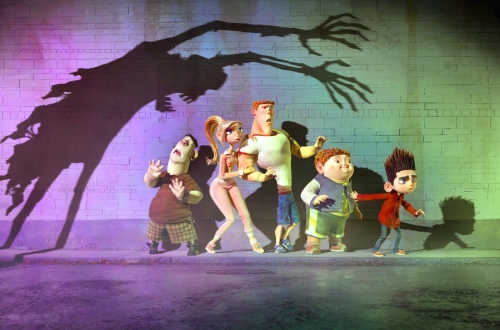
I”m quite keen on a good animation. As anyone who has met me will attest, I have
a small fixation with Wall-E, and hold many of its peers in high esteem – few higher than one of my all time favourite films “Cloudy With A Chance Of Meatballs”. As such, when it comes to animation, I have been around the block. Having only recently caught Paranorman I am happy to say that this surpassed whatever few expectations I had of this. What was a release that slipped past me last year as some loveless film for kids has become my surprise kids film of the year – filling the void left by my disappointed expectations of Brave.
Paranorman echoes much of the knowing humour of CWACOM, and similarly manges to balance it with a cracking, easy to watch masterpiece that kids will enjoy too. The story of Paranorman subverts the traditional children”s narrative while keeping thoughts critical. A child, Norman, is born in a world in which he does not fit. He is peculiar in his difference, and finds that his difference makes him special, but struggles to really his individuality into something positive.
The subversion comes in that his gift is that he can see dead people, sharing a peculiar skill that only his Uncle – a reclusive oddity that is shunned by the rest of the town – dares mention, and in a town built on a history of ghosts and witchcraft. Believing
him to be deluded, his family hope he will break from his phase, and fail to see the truth that was staring at them all along – just how special he is.
The look of Paranorman is magical – managing to capture something of the ghostly quality of stop motion animation into an aesthetic that looks clean, and crisp – and is put to good use in a distinctive online casinos australia world. Filled with humour, Paranorman manages to amuse horror fans while keeping Kids interested with a tale that is just as dark as they could hope to cope with, while never overstepping or abusing its position. A very intelligent, funny and beautiful film that I would be happy for my kids to fall in love with.
Oscar Hopes
There is only one nomination and that is for Best Animated Feature, alongside Brave, Frankenweenie, Wreck-it Ralph and Aardman”s Pirates!, a collection of films which all have their charms. The category is such an oddity that it seems hard to try to rationalise how any decision can be made – are we looking here for animation and style, or should we be focusing on the best film which happens to be animated? The look and feel of Paranorman is so utterly distinctive that comparison seems impossible, but it certainly surpasses the almost clumsy Pixar offering of Brave, and Burton”s Frankenweenie unfortunately lags behind Paranorman while attempting to do something similar, but with a more tired invention. Wreck-it Ralph, still technically unreleased in Britain, promises to be as equally well written and different which means it may be the biggest competitor, if judged with this kind of criteria – in fact, both attend to fans of different cultures – Wreck-it Ralph indulging the fantasies of avid arcade gamers, while Paranorman is soaked in reference to trashy horror films and other low-art films, it might be worth considering which offends the Academies” sentiments the most! As it is, I would personally love to see Paranorman win, but almost all of the films in this category are equally deserving but for different reasons – but are unfortunately inseparable offerings due to their diversity (bizarre as that sounds). Potentially a very difficult category to predict.

So I have had the utter joy of experiencing both Yann Martel”s novel “Life of Pi” and Ang Lee”s film re-imagining in the space of a month, which means my experiencing of both texts has been intensified – a position in which I imagine many will find themselves. My thoughts as such centre strongly around the idea of the film as an adaptation, rather than as a film in itself – unlike other adaptations, this can hardly be ignored due to the nature of narrative that is central to both texts.
Not wanting to spoil either works, I”ll try and make this pracie spoiler free… Life of Pi follows the remarkable story of an Indian boy, called “Piscine” but nicknamed Pi, born into a family that runs a zoo. Raised against a background of a new, emerging India, Pi struggles as a child of a changing nation, who
has placed himself within Hindu, Catholic and Muslim belief systems – but enamoured entirely by the notion of God, and his relation to it. However, his more rationalist family finds themselves in financial trouble, and so it is decided that the family is to move to Canada to start a new life. Having to sell their most exotic and most beautiful creatures, the family travel across the Atlantic in a freight vessel to care for the animals – but on the journey, shit happens and then we get the body of the film – so I won”t say any more. Unlike the actual film which played dramatic extracts from the movie on the actual reel – between the BBFC certificate and the start of the film, which was atrocious.
As a film, I think Ang Lee has comfortably accomplished what many saw as the impossible – that is capturing the remarkable and dramatic events of the book on screen. Attempting such a thing before now would have been near implausible given the necessary direction of animals that feature heavily in the text, but now that the technology of CG has advanced, Lee has managed to create a film using what is available to him, but even massaged a remarkable attention to the themes through innovative use of these technologies. This is important, as it is not simply a great story which needs to be told – it is the story of a novelist hearing the story and struggling to find what he needs between the truth and a tale in what he is told. It is this element which helps to lend the work an important edge, as it is here that Life of Pi becomes an allegorical tale that centres around beauty and narrative – which are supposed to engage the viewer with the essence of spirituality. From a personal point of view, this notion of spirituality was weak in the original text, and thankfully this aspect of the work is underplayed in Ang Lee”s adaptation, but Lee has instead held onto the essential question of structure and narrative devices from the book. As far as this transition from page to screen, although there are a number of scenes and chapters missing which I would have liked to have seen included, it is at least unproblematic in this respect. If you haven”t read the book, I doubt you will find much to fault in how the story is told.
As usual for Ang Lee, what makes Life of Pi stand out is the exceptional cinematography which sets this film apart. Rather than linger on the isolation, boredom and survival that bleeds through the ink, Lee”s work is built to be beautiful, enriching the occasionally turgid text far beyond what it had described, and replaces it instead with an epic universe and its beauty. Composition, colours and reflections push the film”s true meaning into the forefront by using devices which are specific to that medium – eschewing a faux-documentary realism which other directors may have been tempted to employ.
However, seeing the film in 2D – but in high quality All of Caesars‘ qualities in Atlantic City are joining with 888 Holdings the Tropicana Resort chose Gamesys Limited the Trump Taj Mahal has an offer with Ultimate Gaming while its sister-company, the Trump Plaza Hotel and Casino has an offer with Betfair. Imax 4k blah blah – some of the cinematography looked unwieldy. Yes, perhaps it isn”t the ideal way, but one could know exactly what the 3D experience would have been, and it would have been underwhelming, but most importantly it is the 2D version which will be kept and treasured for years to come – and ultimately, I can”t help but feel that the 2D version of the film suffers in an attempt to create a 3D experience.
As a side note, I was appalled to see that the screening I was in had a small insertion of clips from the film prior to the film – between the certificate and the start of the film no less – which was, frankly, utterly abhorrent. I may not be usual in wanting to avoid trailers and want to experience, but surely this must be a trend we have to ask be stopped? For almost all of the films I have actually ventured to a cinema to see, I have been punished and nearly had my experience entirely ruined by some cheap marketing footage pre-empting what is about to be seen – another feature of the cinematic experience which has to be ended if it is to maintain any competition to pirating the films.
Oscar hopes
As far as the impending award season – it”s up for a lot, but has some interesting competition meaning that it will almost certainly win something, but probably not one of the bigger prizes. As far as Best Film goes – I think it will struggle. It”s a long list of nominations, and each are brilliant in their own way, and many of the other films stand on their own as great films far greater than Life of Pi does, in my opinion. This isn”t a film I could watch again any time soon, where as some of the other contenders are fast becoming some of my favourite films of all time. However in the lesser categories there is a greater chance of success, with only the staggering work of Roger Deakins in Skyfall really challenging it for cinematography, and even direction Ang Lee might have a shout – although not necessarily for this film, but as a director in general (as so often becomes the case in the politics of the academy). Editing too is a likely win for Life of Pi, as it is very rare that one notices the editing in any film, and it”s intricate flat layering of material (associated with the 3D) mean so in this it has. This aside, even with 12 nominations, I don”t think it will pick up more than a handful of awards, with more technical elements of the piece really standing out against strong competition.
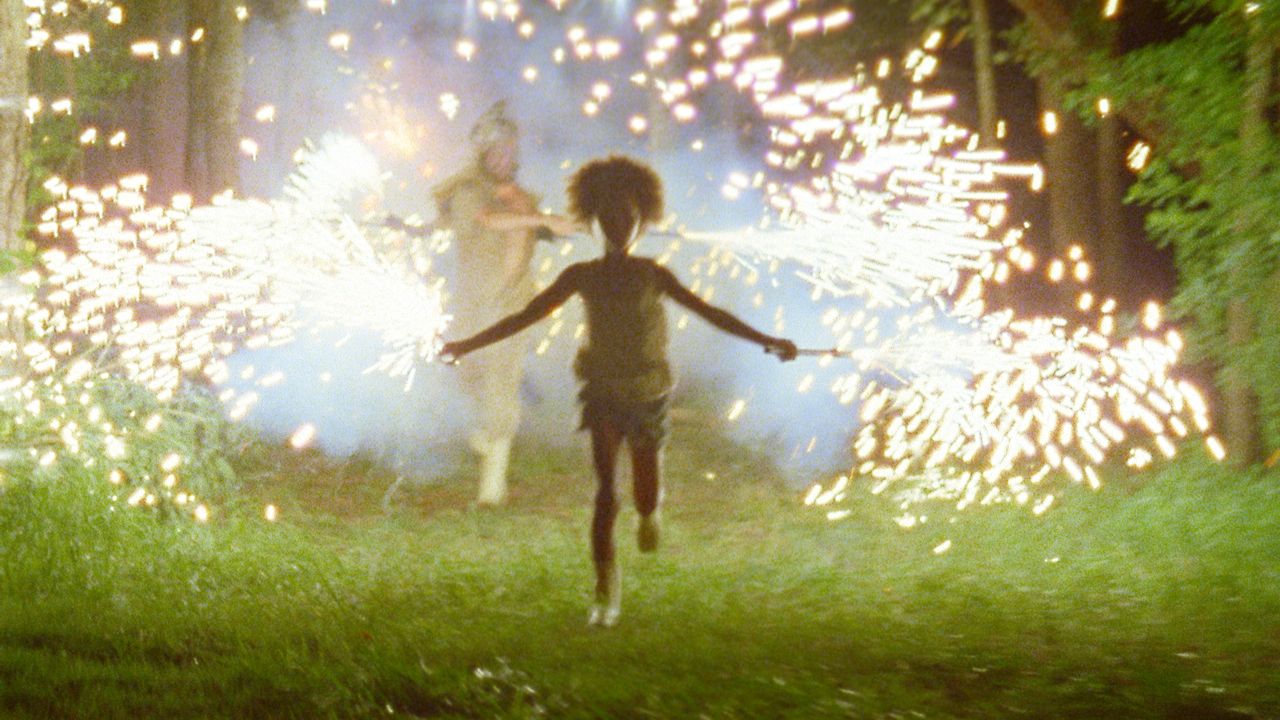
There are some
films which you watch, and know at once are brilliant. As the credits roll, your heart skips and you leave the cinema with a smile on your face, even though your heart has been plucked by an orchestra of emotions. Your head tilts back and, gazing at the starry sky, your feet wander without thought or common sense towards a pub, or watering hole, and find yourself, sat with friends who ask why you have such an inane grin on your face. Your reply: “I've just been to the cinema”. And then you are lost for words.
In the case of Beasts of the Southern Wild this loss of words isn't quite the result of the sublime, as “being lost for words” is so often used when faced with a gargantuan effort of nature, but
simply not knowing the words to say because you can't remember what happened. The film was an incredible testament to the pure perseverance of narrative over and above the cowardly limitations of “budget” or “realism” that hinders most films, a production effort of such magnitude in itself that the sublime description could be merited. But when I come to explain what happened – it all just falls apart.
I've been spending the day trying to figure out how best to describe it – trying to imagine some concoction of Kevin Costner's Waterworld (through setting rather than tone) dashed with Spike Jonze's brilliant effort Where the Wild Things Are, and maybe a little sprinkling of the Shawshank Redemption – it's cultural sense of imprisonment – or even a pinch of Jurassic Park, throw into the pot. As is so often the case however, these descriptions are not only lazy, but become wholly inadequate for a film so intensely cinematic.
The canvas is a world built in the swamps of some American state, in which a community outside of society – refugees of culture who learn to survive and thrive in the harsh, but bounteous, conditions that nature provides – prepare for the oncoming floods sent by the rising tides of Global Warming. How this community begun, where and when it's based, and even how it sits thematically are difficult to pin down – or at least demand multiple viewings for clarity.
The central thread in a hypothethical post-apocalyptic future (after a Katrina-esque bout of extreme weather) is perhaps easier to fathom – the lives of those living in the Bathtub, the name of the island which is somewhere between a rich jungle and an episode of Scrapheap Challenge, is seen through the eyes of a young girl called “Hush Puppy”. With the naiive and beautiful logic of a child, she matures through her childhood without a mother, and with an alcoholic father who clearly loves her, but is unable to express this to her physically and looks on as her father, unable to cope with the burden and gravity of life as he finds
it, drinks, creating his own fantasy in which to reside. As a result, the bathtub becomes this inexplicable space that is never in question but ultimately never understood even by its protagonists. The beat of life, in the hearts of chests, the thunder of wild beasts and the weather that cruelly lashes at the community, run throughout the film, constantly expressing this bewildering mix of spiritual imagination, of The disposable-play slots, poker, blackjack, roulette mobile.the-best-casinos-online.info/roulette.php along with other casino table games will operate via Facebook. the child as much as those around her, with a visible and tangible realism that renders the film's fantasy more than any expressive sense of illusion.
Ben Zeithlin's masterpiece is itself a story of community, with the production of the film so clearly made possible by the strength of its team than blistering vision of an individual, having to work with a startlingly small budget and the project growing within the Bayou community in which it is set. Alongside the production crew, the mesmerising soundtrack is well worth endorsing – an almost Beirutian composition by Dan Romer, with passionate string evoking an epic folk, even nautical, tradition – and punctuates drama brilliantly, while knowing full well when this world needs to be shown in silence. Within the outstanding cast itself however, it is the phenomenal performance of six year old Quvenzhané Wallis which staggers the most, and will surprise few if nominated for an Academy Award. But applause should never be pointed at one sole artist for this work, as it is clearly community that has driven its production – with even the Louisiana landscape improvising as part of the cast at times.
Writing about the film, with this slippery context of complexity, makes it feel almost dreamlike but this is only felt as I recount what happened – when sat in the cinema nothing is every confusing, or indistinguishable, and the world is performed with a semblance of documentary – it simply cannot lend itself well to my own written analysis. It might instead be considered a compelling illusion that deserves close attention, but does not permit itself to be victim to such rigour. It's brisk and swift. Concise and beautiful. Self-contained magic that foreshadows the fears of climate change. The world is so well defined and ultimately real, that you don't for a moment question the context or reality, one can only be immersed.
So having had a few hours to try and explain to my friends what I thought of the film, I've laid down my feelings in words, tried to match expression to emotion and am still utterly unconvinced by my own efforts. I don't think this review is even nearly legible, let alone critical enough, to make sense. But I do know the next time someone asks why I have such a grin on my face I will let them know as honestly as I can without spoiling anything else: “Just go and see that film”.
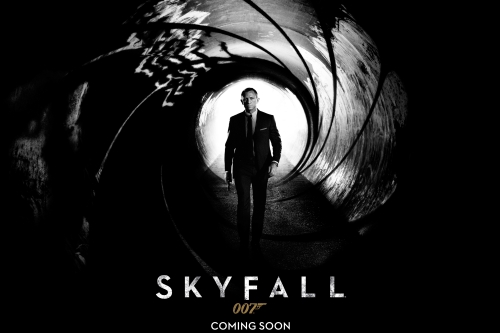
The latest James Bond film seemed the perfect opportunity for us to try out a new feature on the site. As a collective we will be going to cultural/lifestyle events, so that you have a balanced opinion we will then each individually give you our thoughts. This is our review of Skyfall. More opinions will be added over the course of the next few days. Enjoy.
Angus Niven
Skyfall, Skyfall, Skyfall. Am I right?
Yes I am
End of review? I wish, frankly that’s all I feel is necessary. If you have seen it you understand, Skyfall is sublime. Skyfall constructs and deconstructs and then recoonstruc again some of cinemas best known but under defined characters. M, Bond and Q are the headlines of course, but there are some other surprises tucked in there also.
The development of 50 year old characters aside Skyfall is the epitome of British action cinema. The second unit direction is flawless, fast paced ludicrously beautiful sequences are scattered amongst the luscious development arcs.
Shanghai and the Highlands play host to my two favorite action sequences. No qualifications, they are two of my favorite action sequences ever full bloody stop.
Now obviously I have avoided spoilers, I have rewatching the advert it is clear I can talk about two things I enjoyed (without spoiling the film).
1) Q. It’s no secret that q is back, back and younger than ever. There is a good deal of complaints regarding his hipster glasses and youth. Well those moaning myrtles can shut it. The youth of Q is a pretty accurate representation of GCHQ’s current batch of Boffins. Barely 2 weeks ago William Hague was at Bletchely Park to begin the recruiting drive for the Foreign Offices team who are “a little bit naughty”. Taking on the best and brightest naughty folk within the cyber community is the only way for modern security to keep up. Q is vital in any future iterations of Bond whether you like it or not a convincing spy thriller will require some key tapping cyber warfare. Q cracks wise, wears cardigans and designs algorithms personally I would prefer to have him at the keyboard than James (or a square).
2) Ralph Fiennes finery. Tom Ford has once again been called upon to transform Skyfall into the greatest cinematic showcase of Sartorial elegance since Giorgio Armani’s turn In “The Untouchables”. Of course Bonds Dinner attire in Macau is the highlight and his figure hugging daywear is ludicrously revealing (which apparently is popular with some people). I however felt it was Fiennes slightly retro assortment
of suits where the costume department were really showing off. Drawing on everything from double berated waistcoats and his ever present braces Fiennes creates the most ludicrously well tailored public servant since Anthony Eden.
So go and see Skyfall because somehow, 50 years and a few thousand martinis on James can still pull an honest to god classic out of the bag (and seduce you with it).
Elyse Jamieson
I had high hopes for Skyfall; so high that I actually got out of bed on an incredibly cold evening and travelled all the way across Edinburgh to go and see it on its day of release. Thankfully, it did not disappoint. As ever, Daniel Craig is a superb Bond – the perfect image of a spy, cool yet considered – but the central focus shifts a little towards M, wonderfully played as ever by Dame Judi Dench. It was great to see a strong female character with such a prominent role in a blockbuster movie. The same applies to a lesser extent to Eve (Naomie Harris) and Sévérine (Bérénice Marlohe), although her story is not given the attention it really deserves.
It is also nice to see Bond’s creators acknowledging that nowadays, threats to the state are likely to be of a technological nature rather than an all-guns-blazing kind of affair. Of course, there are still a few (major) explosions, but the gadgets utilised by Q (Ben Whishaw) and the main thrust of the plot, a stolen hard drive, seem to give the film a greater relevance while still providing an indulgent escape from reality.
Skyfall is also a beautifully shot film, especially when its protagonists pay a visit to the heathery hills of Glen Coe. With a solid, if basic, storyline and a fantastic cast to back it up, this Bond is certainly one to get on board with.